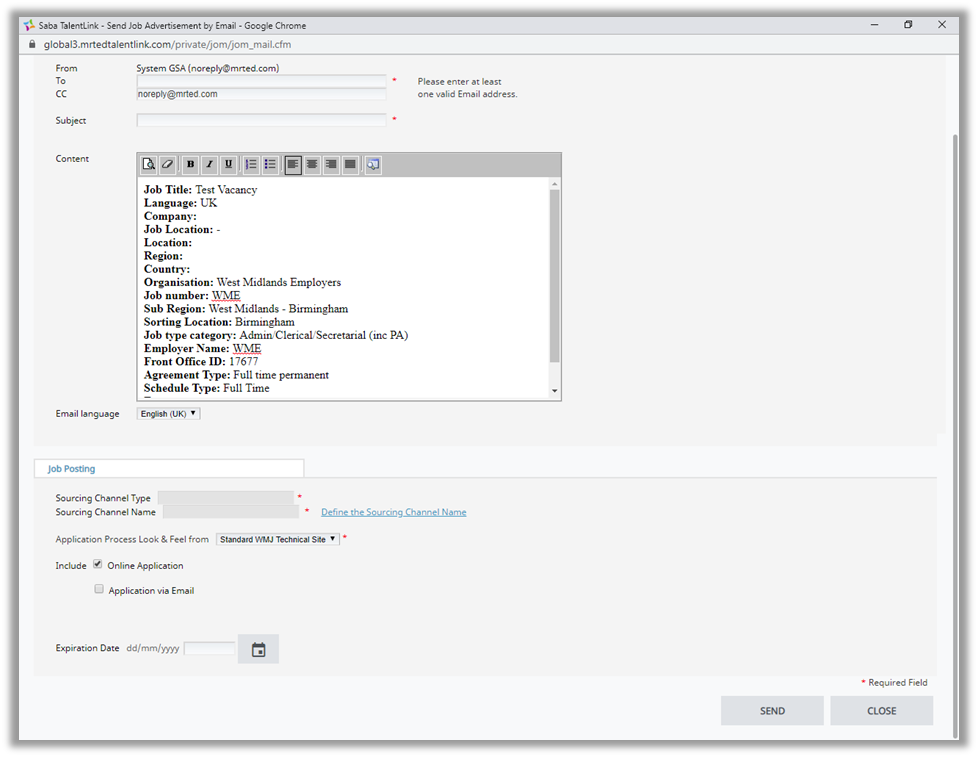
With the removal of the Candidate Home Page, this has opened up the possibility to use pieces of functionality inside the TalentLink system which, up until this point, have been unable to utilise - this includes the 'Send Job Advertisement by Email' option.
This allows you to send an email from the system which includes a direct link to the application form, which is particularly useful for adverts which need to be ring-fenced to specific audiences, such as an internal secondment opportunity.
To access the functionality, navigate to the Posting tab of a role, click the plus icon and select Send Job Advertisement by Email:

A pop-up box will appear where the system will ask you to enter an email address of who to send the email to and the subject of that email:

Enter who you would like to send the advert to under To and the subject.
Please note that you can both of these fields are mandatory and you must have a minimum of one valid email address to send the email to.
To send the email to more than one email address from the system, all you need to do is insert a semi colon without any spaces.
The email will be sent from the connected user.
Note: you can email this to yourself as a user and circulate to the appropriate distribution list as needs be for the role.
If you’re going to send the email directly from the system, you’ll see in the box that information about the job and the job advert are already auto populated. You can edit this as you would any communication template, however it is important to remember that the link contained in the email will direct the candidate to the application form, not the advert itself, so you may wish to consider keeping some or all of the advert text in the email.
When using this functionality, you are able to define a Sourcing Channel via the email which means, if you email multiple audiences and define each of the sourcing channels/types, you are able to see who has applied from where, which will be really useful in terms of analysing that data.
Under Sourcing Channel Type, click into the box and select from the drop-down options External site:

An option will appear underneath for External Career Site to be selected:

Click Select.
This will populate the Sourcing Channel Type and Sourcing Channel Name.
Alternatively, if you wish to create a custom sourcing channel name, navigate to the ‘Define a New Sourcing Name’ section and enter your custom source name e.g. Finance Ringfence Jan 2021.
You’ll also be able to see the sourcing channel if you add this as a filter to your Selection/Hiring tab. You can also report on the sourcing channel via AdHoc Reports.

The system will then ask you to Application Process Look & Feel. Here you need to select ‘Standard WMJ Technical Site’.
You then have the option to include a link to the online application. You can do this by ticking Online Application in the Include section:

You also have the option to invite the candidate to apply by email. This would include a hyperlinked email address in the email for candidates to send an application.
Whilst this is a simple option for a candidate, all you get is what the candidate sends you e.g. CV. So where an online application would always include a Personal Information Form and is likely to include a diversity form as well as application consent. This type of information is not captured when using the application via email functionality.
You can include an expiration date for applications, which in real terms, would be the closing date for the role, just as you would enter if you were posting the job to the external site. Please note that you are not required to post the job to the external site in order to use the Send Job by Email functionality.

Once you are happy with the content of the message and the other details, click Send.
If the email is being sent to the candidate directly, they just need to click on the link to access the application form.
If you’re using the link to insert into your own communication, simply right click on the link and select ‘copy hyperlink’. This can then be pasted to a location to suit your requirements.
Was this article helpful?
That’s Great!
Thank you for your feedback
Sorry! We couldn't be helpful
Thank you for your feedback
Feedback sent
We appreciate your effort and will try to fix the article